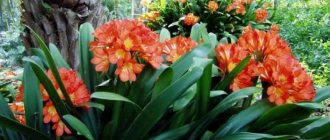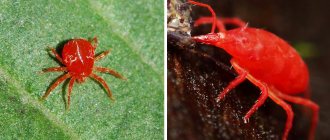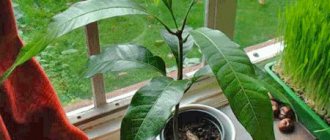2. Propagation of indoor plants
Throughout its life, the plant produces lateral shoots and basal suckers , which are used for vegetative propagation in spring or summer.
- Cuttings of aglaonema are best done in a special heated container, in vermiculite.
- Often cuttings take root even in a simple glass of water. You can even plant stems that have taken root and do not have leaves - they will begin to grow from the awakened lateral buds and will produce additional shoots from the buds that are located underground.
- Such stem cuttings should be placed horizontally, lightly sprinkled with moist soil - this will make the plant more lush, because leaves and roots will appear in each dormant bud.
- The successful completion of the rooting process will be indicated by the appearance of signs of new growth - young shoots.
Many varieties of Aglaonema are propagated by seeds and air layering . Seeds germinate in 25 - 30 days. For propagation, only freshly collected seeds are used.
Large adult specimens are propagated by division , which is carried out in the spring, during transplantation. The bushes are divided in such a way that each part ultimately receives its own, well-developed root system and green ground part.
↑ Up,
4.Aglaonema - home care
4.1.Soil
Well-drained, loose, moisture-permeable soil made from leaf humus, coarse sand, peat, heather soil.
The substrate should have good drainage and easily allow both moisture and air to pass through to the plant's root system.
↑ Up,
4.2.Watering
abundant watering during warm periods. In winter, the frequency of watering is reduced, but without allowing the earthen clod to dry out.
The flower suffers from excessive watering and stagnation of water in the pot.
Drain excess water from the pan within a few minutes after watering.
Water only with warm, soft water; the frequency will depend on the temperature and the degree of illumination.
↑ Up,
4.3.Growing, how to prune
Aglaonema is quite capricious and often does not forgive violations of agricultural practices.
The plant does not tolerate low temperatures well - it curls the tips of the leaves and does not like cold drafts.
During the winter months, plants often develop some yellow leaves at the base.
Tall varieties may require support to grow.
Plants will appreciate periodic bathing in the shower during the warmer months.
It is worth pinching old, yellowed leaves in a timely manner.
To prevent the plant from wasting its energy on forming flowers, the buds immediately removed . Pruning is carried out only with a sharply sharpened and sterile instrument.
In the summer months, you can take the flower out into the fresh air , placing it in a place where it will be protected from direct sun, strong gusts of wind and rain.
4.4.Lighting
Green-leaved varieties are shade-tolerant and suitable for poorly lit rooms; they can get burned when exposed to direct sunlight.
When grown indoors, variegated varieties, especially red ones , need more sunlight than green ones.
If aglaonema lacks sunlight, use artificial illumination with fluorescent lamps.
↑ Up,
4.5. Fertilizer of aglaonema
Flowers in pots have a limited feeding area and need regular feeding .
In the summer, every 2 weeks we feed the aglaonema with flower fertilizers with a minimum amount of lime; We do not feed the plant in winter.
4.6.Temperature
House flowers grow well at room temperature, during the period of intensive growth - 20 - 25 ° C. The minimum temperature in winter is not less than 15°C , although it can briefly withstand a drop of up to 10°C.
The flower comes from tropical latitudes; it does not require a winter dormancy period, although it is welcome.
The plant does not like sudden changes in temperature and intense summer heat (more than 26 ° C).
↑ Up,
4.7.Air humidity
Likes regularly ventilated rooms, however, without cold drafts.
Aglaonema prefers high air humidity and regular spraying with soft water, but it tolerates dry air only for a short time.
A flower pot can be placed in a tray with wet pebbles or sphagnum moss; a room humidifier or a decorative fountain can also be used to increase humidity.
↑ Up,
When and how does it bloom
You can rarely see how aglaonema blooms, but with proper care in the summer, the plant produces an inflorescence - a spadix with discreet small flowers.
Types of flowers
Depending on the variety, aglaonema can bloom with thin, cylindrical (5 mm in diameter, 4 cm in length) or thick, club-shaped (1 cm in diameter, 3 cm in length) flowers.
Flower shapes
Aglaonema inflorescences are pale green in color, collected in a spadix 3 cm long. Inflorescences appear in the 1-3 axils of the upper leaves.
Flowering period
Aglaonema blooms from June to August. After 8 months, bright red berries ripen, less often white, oblong, containing one seed each.
Changes in care during the flowering period
Proper care at home will help you make the aglaonema flower bloom: just prepare a wide and shallow container, maintain regular spraying and watering, and maintain a stable temperature.
Aglaonema during flowering
Advice. Feeding the plant with bone meal will help speed up flowering.
6. Transplantation of aglaonema
Replant as necessary - about once every three years , since the plant grows rather slowly.
Don't use a pot that's too big—aglaonema grows best when its root system is cramped .
Try not to disturb the root system again and use transshipment along with a lump of earth.
When transplanted, adult plants that form a trunk are placed horizontally - at the same time, dormant buds wake up on the stem and each of them forms its own leaves. As a result of this procedure, you can get a chic, lush plant.
Planting in fresh soil is carried out in the spring , when the plant wakes up and demonstrates its readiness to develop.
↑ Up,
How to transplant aglaonema correctly
Replanting aglaonema has its own significance; a flowering stem will not long please with green foliage in a pot that is too cramped. Moreover, young plants are replanted annually, due to the speed of their growth, and mature ones - a little less often. The following principles for replanting this plant can be noted:
- Soil: the substrate should be crumbly, as for heather or azalea. A mixture of humus, sand and charcoal mixed with soil is perfect.
- Pot: a young plant needs a diameter of 12 cm, and a mature one about 18 cm. It should not be too deep.
- Drainage is required; you can add some pebbles to the soil.
- Time: the greatest benefit from replanting is achieved if it is carried out at the very beginning of spring. At the same time, you can divide the bush into shoots and plant them separately to increase bushiness.
- After replanting, 3 weeks later, you need to fertilize the soil in the pots. This can be done using the following means: “Lignohumate”; "Agricola"; "Effecton".
8.Note
Do not grow this plant in homes where there are children and animals, as its juice and berries are poisonous .
After 3 - 4 years, the plant begins to lose its lower leaves, exposes the lower part of the shoots and becomes untidy - it needs to be renewed . Replace it with a young bush by cutting and rooting the top.
Aglaonema grows best in a tropical " flower window " with constant temperature and humidity.
These decorative leafy bushes are able to purify the indoor air from many harmful impurities - for example, formaldehyde and benzene.
From time to time you can notice small transparent droplets on the leaves - the plant seems to be “ crying ”. There is nothing wrong with this - it’s just that at this time the flower is kept in high air humidity or the weather outside is cloudy and rainy.
↑ Up,
Diseases and pests of aglaonema
If gray or brown soft spots appear on the leaves and stems of your pet, then most likely it has developed gray rot . While the disease is in its early stages, you can try to cure it by spraying with Topaz or a 1% solution of Bordeaux mixture. If the disease has already affected most of the plant, it is necessary to remove all above-ground and underground affected parts and transplant the aglaonema into new soil and pot.
Quite often, aglaonema is affected by a fungal disease - rust . You will recognize it by the golden yellow spots on the top of the leaf and the orange velvety pads on the bottom. The affected parts of the plant will have to be removed and ground sulfur sprayed on the rest.
If aglaonema grows weak, it can be attacked by pests.
- Mealybug. White fluffy pests on stems and leaves. As a result of their invasion, the leaves dry out, curl and fall off. Insecticides such as Actellik, Fitoverm, Fazol will help in the fight against them. Use them strictly following the instructions on the packages.
- Spider mite. Recognizable by small cobwebs on the bottom of the leaf and axils. Spray the bush with Aktara or Zolon, according to the instructions. You can also try the traditional method - bathe the aglaonema in a hot shower (about 45 degrees), manually washing off all the cobwebs and insects.
- Aphid. Aphids can be easily seen on the bottom of the leaf. Use Actellik, Aktara, Lannata.
- Shield. It can be seen with the naked eye. These are brown tubercles located on the leaves and stems of the plant. Scale insects should be removed manually, removing each specimen using a damp cloth soaked in a soapy solution. The procedure must be repeated several times with an interval of 3-4 days, since after the first time larvae may remain.
- Thrips. These are very small insects located on the back of the leaf. Thrips larvae are found in the soil, so the first step is to remove and discard the top layer of soil from the aglaonema pot. Then wipe the leaves and stems with a sponge and soapy water, and after 4 hours, spray with Fitoverm solution.
- Whitefly. Small flying insects are white. They live on the underside of leaves. Use Confidor, Mospilan (1 treatment) or Actellik (up to 4 treatments every 5-6 days). Common means of repelling flying insects - a fumigator and adhesive tape - can also help.
10.Types of aglaonema:
10.1.Aglaonema changeable - Aglaonema commutatum
One of the most common species of this genus. An evergreen herbaceous perennial of small height - about 50 - 60 cm. The leaves are variegated, striped, thick, spear-shaped, shiny, the main tone is dark green, have an attractive silver marking along the main vein, the length of the leaf plate ranges from 10 to 30 cm, width - from 4 to 10 cm. The leaves are located on short, erect, sometimes branched, glossy green stems, reaching two meters in height for several years. This aglaonema blooms rarely, the peduncles are tall - up to 20 cm, the flowers are axillary with a pale green veil, collected in an inflorescence - a spadix, usually appear at the end of summer - until the beginning of autumn. The flowers are small and inconspicuous, reminiscent of small greenish-white callas.
The fruit is a yellow oval berry that changes color to bright red, less than 1 cm in length, which gives the plant additional decorativeness. The plant resembles Dieffenbachia in appearance and is used as an ornamental foliage plant. An easy-to-care plant that prefers loose, rich soil and plenty of watering. Varieties of aglaonema changeable differ in the color of their leaves; it is worth remembering that the more pronounced the variegation, the more the plant needs light.
↑ Up,
10.2. Curly Aglaonema or Robelena - Aglaonema roebelenii
An evergreen perennial, about 1 m high. The stems are densely covered with long, elliptical, hard, leathery leaves with silver-gray veins and dark green edges on short petioles. The length of the leaves ranges from 20 to 30 cm, the width is between 8 and 13 cm. It is grown mainly in greenhouses and winter gardens due to its large size for its variegated leaves. The flowers are relatively long, greenish and not particularly noticeable. They attract more attention when they turn into red berries. Aglaonema curly requires warm conditions throughout the year and diffused light or partial shade; it does not tolerate direct sunlight.
↑ Up,
10.3. Aglaonema Maria - Aglaonema Maria
An evergreen ornamental foliage plant with oblong dark green leaves covered with light green transverse stripes. It is resistant to low light levels. It successfully tolerates short droughts and is successfully grown under artificial lighting.
↑ Up,
10.4. Aglaonema Silver Bay - Aglaonema Silver Bay
A large plant - the bush reaches 1 m in height. The large leaves of this plant are distinguished by a light green or silver-gray base tone and a darker edging of the leaf blades. This plant tolerates a wide range of temperature conditions and grows well under artificial light. Aglaonema Silver Bay tolerates both short droughts and floods.
↑ Up,
10.5.Aglaonema Crete - Aglaonema Crete
This variety is also called “red aglaonema” because of the distinctive color of the leaves - they have a salmon or pink edge and spots of the same color scattered on the leaf blades. The underside of the leaf blades is also painted pink. A very stylish, elegant plant. Aglaonema Crete does not like bright lighting.
↑ Up,
10.6. Aglaonema painted tricolor - Aglaonema pictum
A spectacular ornamental, slow-growing subtropical houseplant. This variety has large, glossy, narrowly oval leaves. The leaf blades are dark green with lighter green and almost white spots, reminiscent of camouflage. With age, these flowers form strong stems covered with light brown bark. Even adult specimens remain compact and often do not exceed a height of 30 cm.
↑ Up,
10.7.Aglaonema pseudobracteatum
Narrow-leaved aglaonema with dark green, glossy, pointed leaves on long, relatively thin petioles. The surface of the leaf blades is abundantly covered with light green and white spots, and the central vein is highlighted in green.
↑ Up,
10.8. Aglaonema ribbed - Aglaonema costatum
Slow-growing, large-leaved bushes up to 60 cm high with oblong, pointed leaves up to 20 cm long. The leaf blades are emerald green or very dark, almost black, the central leaf vein is highlighted in a lighter shade.
↑ Up,
10.9.Aglaonema oblong-leaved - Aglaonema marantifolium
Perennial evergreen plants with oblong-elliptical glossy leaves on long, thin petioles. The leaf blades are dark green, with small light green and transverse stripes. Plants are tall and can reach a height of 60 cm.
↑ Up,
10.10.Aglaonema modest or moderate - Aglaonema modestum
These plants are considered one of the most useful in the house - they can effectively cleanse the polluted atmosphere of many harmful impurities. In addition to its benefits, this plant surprises with its attractive appearance - it has broadly lanceolate, glossy, entire leaves, colored dark green. Variegated varieties are distinguished by the presence of light green and white spots and stripes.
↑ Up,
Where to put an aglaonema flower
The home aglaonema flower should be placed according to whether the species loves light or prefers shade. Most species prefer shaded areas, so a window sill on the south side of the house is unlikely to be a comfortable place to grow them.
It is worth noting that varieties with red leaves tolerate the sun better than others; they love good lighting. The general rule is: if the foliage of the aglaonema is within the boundaries of a right angle (minimum 40 degrees), then the lighting for it is optimal. If the foliage drops lower, the lighting should be reduced slightly.
Growing aglaonema in summer requires some additional darkening; in winter, on the contrary, you need to add a little light.











